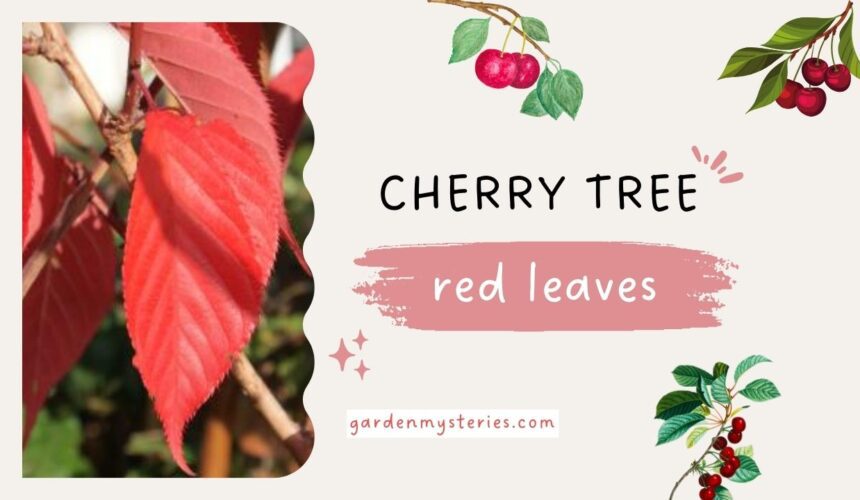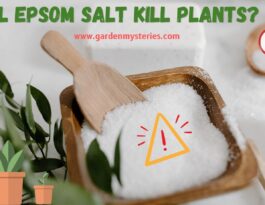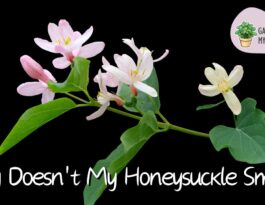Red cherry leaves are something to worry about and when it happens, the first question that crosses the mind is, ‘Why does my cherry tree have red leaves?’ Red cherry tree leaves can result from cherry leaf spot disease, aphids, rusty mottle of cherry, etc.
Is There a Red Leaf Cherry Tree?
Yes, there are cherry tree red leaves, such as the Japanese Flowering Cherry (Prunus serrulata ‘Amanogawa’). This variety boasts striking pink blossoms, royal burgundy cherry tree leaves and dark red leaves.
The red foliage adds ornamental value to the tree, making it a popular choice for landscaping. While some red-leafed cherry trees may exhibit seasonal color changes due to environmental factors, the ‘Amanogawa’ cherry maintains its red leaf color throughout the growing season.
Keep in mind that proper care, including suitable soil, sunlight, and water, is essential to maintain the vibrant red foliage and overall health of the tree.
Why My Potted Cherry Tree Is Getting Red Leaves?
Red leaves on your potted cherry tree could stem from various issues, including:
- Leaf Spot Disease: Fungal or bacterial infections like Cherry leaf spot can cause red spots or discoloration on leaves. Improve air circulation, avoid overhead watering, and apply fungicides as needed.
- Aphids: These tiny insects can suck sap from leaves, causing stress and discoloration. Use insecticidal soap, neem oil, or introduce natural predators to control aphids.
- Nutrient Deficiency: Insufficient phosphorus or other nutrients can lead to red leaves. Ensure balanced fertilization and amend the soil with appropriate nutrients.
- Peach Tree Leaf Curl Disease (Taphrina deformans): Although primarily affecting peaches, this fungal disease can also cause cherry tree leaves turning red. Use fungicides and prune infected parts.
- Rusty Mottle of Cherry: Caused by a virus, this disease leads to mottled red and green foliage. There’s no cure, so remove and destroy infected trees to prevent spread.
- Environmental Stress: Factors like improper watering, extreme temperatures, or poor soil drainage can stress the tree, leading to red leaves.
- Prunus spp. Rust: This fungal disease can cause rust-colored spots on leaves. Remove and destroy affected leaves and apply fungicides preventively.
Regular inspection, proper care, and prompt treatment can help address these issues and restore the health and vitality of your potted cherry tree.
Don’t forget to check: Possible reasons and solutions of orchid roots turning brown.

How to Take Care of Potted Cherry Plants?
Caring for potted cherry plants requires attention to several key factors to ensure their health and successful growth. Here’s a comprehensive guide on how to care for your potted cherry plants:
Step 1: Choose the Right Container
Select a large container with good drainage holes to prevent waterlogging. A 15-20 gallon container is suitable for most cherry varieties. Make sure the container is sturdy and provides enough space for root growth.
Step 2: Soil and Potting Mix
Use well-draining potting soil mixed with compost and perlite for better aeration and drainage. Cherry plants prefer slightly acidic to neutral soil (pH 6.0-7.0).
Step 3: Sunlight
Place the potted cherry plant in a location that receives full sun, which is crucial for healthy growth and fruit production. Ensure it gets at least 6-8 hours of direct sunlight daily.
Step 4: Watering
Keep the soil consistently moist but not waterlogged. Water thoroughly when the top inch of soil feels dry, adjusting frequency based on weather conditions. During flowering and fruiting, maintain consistent moisture to support fruit development.
Step 5: Fertilization
Use a balanced, slow-release fertilizer or a liquid fertilizer formulated for fruit trees. Apply during the growing season (spring and summer) according to package instructions. Avoid excessive nitrogen, as it may lead to lush foliage and fewer fruits.
Step 6: Pruning
Regular pruning helps maintain shape, remove dead or diseased branches, and improve air circulation. Prune during the dormant season (late winter or early spring) to encourage new growth.
Step 7: Pollination
If growing a fruit-bearing variety, ensure proper pollination. Some cherry trees are self-pollinating, while others require cross-pollination with another compatible cherry variety. Consider hand pollination if needed.
Step 8: Pest and Disease Management
Regularly inspect the plant for signs of pests (aphids, caterpillars, etc.) and cherry tree diseases (leaf spot, rust, etc.). Use appropriate insecticides or fungicides for different cherry tree fungus. Promote good air circulation to reduce disease risk.
Step 9: Winter Care
Protect your potted cherry plant from freezing temperatures during winter. Move the container to a sheltered location or wrap it with insulating material. Water the plant occasionally during winter to prevent root dehydration.
Step 10: Repotting
Every 2-3 years, repot your cherry plant into a slightly larger container to allow for root expansion. Replace old soil with fresh potting mix during repotting.

Remember, individual cherry tree varieties might have specific care requirements, so it’s important to research and adapt these guidelines accordingly.
Regular monitoring, care, and attention will help your potted cherry plants thrive and potentially yield delicious fruits.
Common Cherry Plant Problems and Solutions
Here’s a table outlining common problems that can affect cherry plants, along with their possible causes and solutions:
| Problem | Possible Causes | Solutions |
| Yellowing Leaves | Nutrient deficiency, overwatering, poor drainage | Adjust watering, improve drainage, fertilize |
| Brown Spots on Leaves | Fungal infection (e.g., leaf spot) | Prune affected leaves, apply fungicide |
| Wilting/Drooping Leaves | Underwatering, root issues, disease | Ensure adequate watering, inspect roots, treat disease |
| Holes in Leaves | Insect pests (e.g., aphids, caterpillars) | Apply insecticidal soap, introduce natural predators |
| No Fruit/Blossoms | Poor pollination, environmental stress | Hand-pollinate if necessary, provide optimal conditions |
| Curling Leaves | Aphid infestation, fungal infection | Treat aphids with insecticidal soap, apply fungicide |
| Rusty Spots on Leaves | Rust fungal infection | Remove and destroy infected leaves, use fungicide |
| Twisted or Distorted Growth | Virus infection, aphids | Remove and destroy infected parts, control aphids |
| Premature Leaf Drop | Environmental stress, disease | Address underlying issues, treat for diseases |
| Stunted Growth | Poor soil quality, root damage, disease | Improve soil, inspect roots, treat disease |
FAQs
Can I use natural remedies to treat red leaves on my cherry tree?
Yes, some natural remedies can help. Neem oil or insecticidal soap can control pests, and compost tea or organic fertilizers can address nutrient imbalances. However, for serious diseases, a targeted fungicide might be necessary.
Should I remove the red leaves from my cherry tree?
It depends on the cause. If red leaves result from a normal color change or minor stress, they can be left alone. If due to disease or severe stress, removing and properly disposing of affected leaves can help prevent the issue from spreading.
Can cherry tree red leaves affect fruit production?
Yes, prolonged stress or disease causing red leaves can impact fruit production. Stressed trees may allocate energy to survival rather than fruiting. Address the underlying issue to promote healthy fruiting.
Was this article helpful? You can also go through our latest article on reasons and corresponding solution of orchid stem turning pink.






